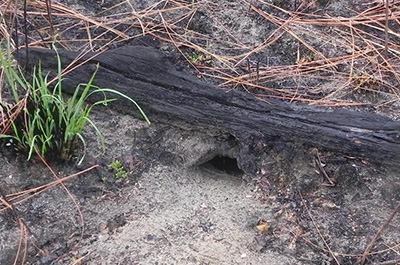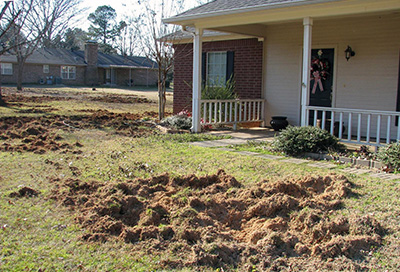Who Made That Hole?

Gardeners are generally pretty attentive to any disturbances in “the force,” and holes in the yard can be quite disturbing to some. Holes and signs of digging are a good indicator that wildlife is visiting or living in your yard.
For most homeowners, a few holes here and there is not a huge issue. But where some gardeners welcome the signs of wildlife in their landscape, others find the disturbances a nuisance. Whatever your stance on the digging of critters, almost everyone wants to know who made that hole.
Holes That Are Homes
Small, shallow holes are often evidence of foraging by grey squirrels and armadillos, but some of the holes you will find in your yard are the homes of critters. Anything less than 3 inches across is likely to be the work of insects, moles, rodents, or snakes. Larger holes that are 6 to 12 inches in diameter and are found near the base of trees, logs, or walls are likely to have been made by a red fox, skunk, armadillo, or coyote. Beyond size you can use other clues like tracks (or even smells) to determine which of these animals made your hole.

Very small holes are often the work of non-mammal creators; in Florida you may find the home of an ox beetle or land crab. Ox beetles (Strategus aloeus), also called Eastern Hercules beetles, create mounds of soil and holes about the size of a quarter. While their holes may be a nuisance, these insects are beneficial as they feed on decaying matter like that found in compost piles, and dead wood.
Only gardeners near the beach might stumble upon a land crab; they’re rarely found more than 5 miles from a coastal shoreline. Land crabs are shy, and if left alone, are not a threat to people or pets. These creatures dig burrows that are 3 to 5 inches wide and can be up to 5 feet deep. Using chemicals to control land crabs is dangerous to both people and the environment and there are no chemicals registered for control of these pests.
Some holey homes are quite distinctive. For example, if the large hole in your yard has a large mound of sandy soil in front of the entrance, you may have a gopher tortoise. The hole made by a gopher tortoise is almost exactly shaped like its shell—more of an oblong circle that is flattened on the bottom then a totally circular hole. Gopher tortoises are a threatened species and both the tortoises and their burrows are protected under state law and must be left alone.
Pocket gophers—which some people call “sandy-mounders” or even more creatively, “salamanders”—are secretive mammals that live underground. These animals create tunnel systems 6 to 12 inches below the surface, where they eat roots and the fleshy parts of plants. Pocket gophers excavate soil for their tunnel system and mound it into large, asymmetrical, crescent-shaped heaps that are about 10 inches across. While these heaps—a lighter color of soil than the surrounding area—have no visible entrance holes, a plug of soil may be noticeable offset from the center of the mound.
Moles also live in underground tunnel systems, but unlike pocket gophers they don’t eat your plants. Moles eat insects that live in the soil. Their foraging tunnels are created just below the surface and can create raised ridges of soil that can be a nuisance for some gardeners. Moles can actually be beneficial in your landscape as they forage for many lawn and garden pests like mole crickets, wire worms, white grubs, and army worms.

Foraging
Speaking of foraging, other animals hunting for food in your landscape may also be tearing up the ground. Foraging armadillos can leave an impression on your landscape in the way of 1-2 inch wide holes that are up to 6 inches deep. Foraging by wild hogs can cause extensive damage as they create deeper holes and ruts across larger areas; it’s hard to mistake the damage done by wild hogs.
Determining who made a hole in your landscape can involve a bit of sleuthing, but with an attention to detail and a good resource you should be able to crack the case.
If you have questions about deterrents to discourage animals from digging in your landscape, contact your county Extension office.
